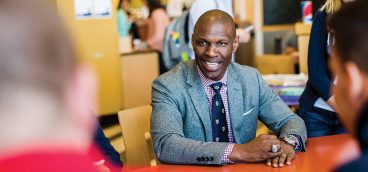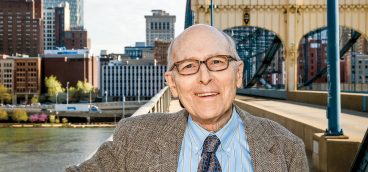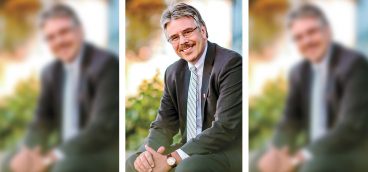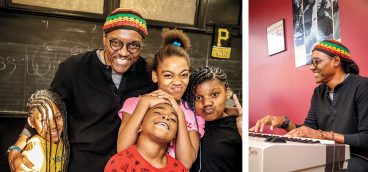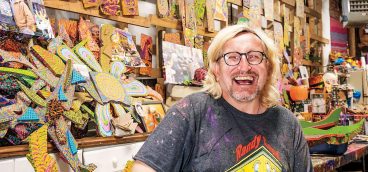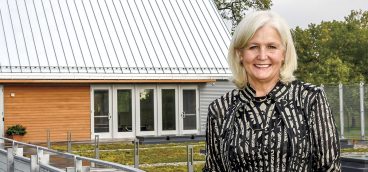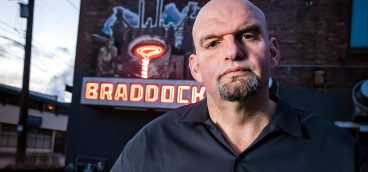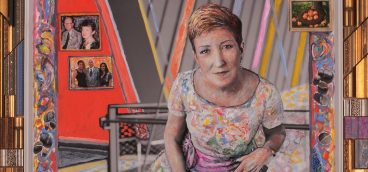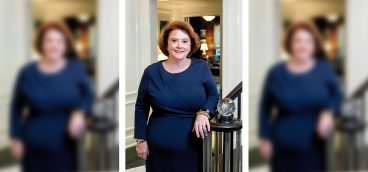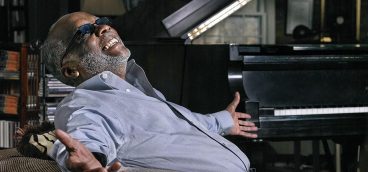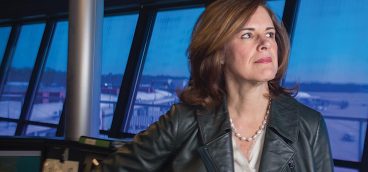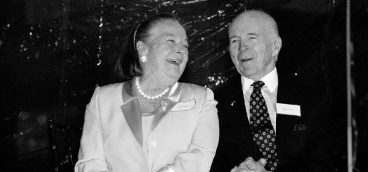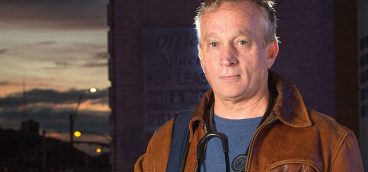An Exemplary Life – Sunil Wadhwani Tells His Story
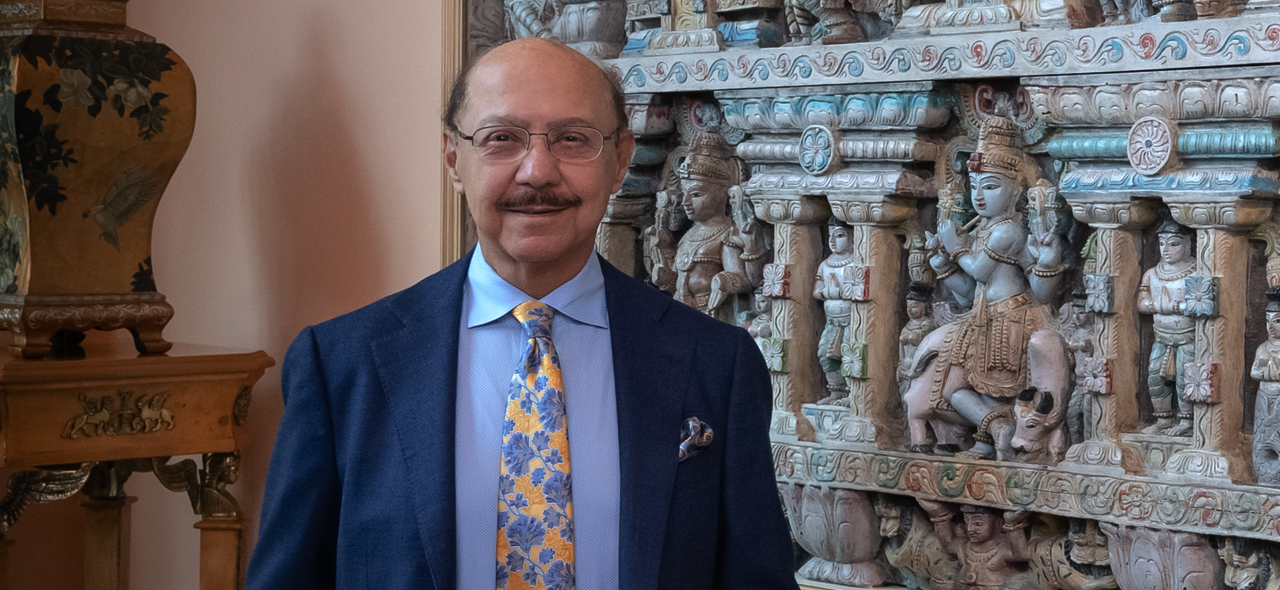
I grew up in India and have lived in Pittsburgh for more than 40 years. I came here to study at Carnegie Mellon University (CMU), and then decided to stay. I started my first company here, which failed. My second company did better. It’s been an exhilarating ride — but the story starts a few centuries ago.
A couple of years ago, my family and I decided to research our family history. Amazingly, we were able to trace our direct lineage back more than 400 years. My ethnic community originated more than 5,000 years ago in what is called the Indus Valley Civilization, in the northwestern part of the Indian subcontinent. “Indus” is an anglicized term for the Sindhu River. People who originate in this region are called “Sindhis,” and that’s what my family is.
What really stands out in families like mine is their commitment to education through the centuries, in times when the majority of the people on the Indian subcontinent — and, in fact, around the world — couldn’t read or write.
India was a feudal society for a very, very long time, with kings and princes governing the various independent states that dotted the map. My forefathers — because of their education, and reputation for integrity and hard work — rose to play senior roles as advisors and administrators for the ruling kings and princes.
If we go back just 100 years, my paternal grandfather still lived in our region of origin, and was the headmaster of one of the largest schools in all of Sindh at that time. To him, teaching wasn’t just a profession; it was a calling. My maternal grandfather was a surgeon, one of the first from India to be admitted as a Fellow of the Royal College of Surgeons in England. Eventually, he became the Surgeon General of Sindh. Everyone in a position of power who needed surgery called on him. He would also perform free surgeries for the poor and the needy.
My father worked for a British bank in India, and was the first Indian to get to the “executive suite” at this institution. So, in my family there was always a sense of “Aim high, work hard and believe in yourself.” We’ve faced numerous serious setbacks and yet overcame them to get ahead in life.
In 1947, upon gaining its independence from Great Britain, India was divided into two countries. My family found itself in the newly formed country of Pakistan, which had been created so that the Muslims of India would have their own land. We were Hindus, a minority in Sindh, but well-integrated and well-established. However, events during the Partition of India caused the Hindus to flee Pakistan and my family had no choice but to leave everything and travel as refugees to Delhi, the capital of India, where we had to start again from scratch. But I never once heard my parents complain about this wrenching upheaval.
I’m the youngest of three brothers. I was born about five years after my family had moved and, at that time, India was chaotic. Roughly 10 million refugees had poured into Delhi in short order. Poverty was exploding, and disease was rampant. My brother, Romesh, who was born 10 days after India became independent, contracted a severe case of polio that he’s had to deal with all his life. My eldest brother, Manik, went to work for the Indian government in the 1950s. When he was in college, the highest aspiration for the best and the brightest in India was public service. Their idealism enabled them to contribute to the development of our new nation.
When you grow up in a country like India, you learn how the circumstances of your birth dictate so much of your life story. In my case, I was born into a middle-class family that believed in education, so my parents sent my brothers and me to good schools. But just a mile away, there were thousands of families living in slums. And for the children who grew up there, life was totally different. Their families weren’t able to educate them. They had few, if any, opportunities. As I got older, I learned to appreciate how fortunate I was, and to understand how much of what we call success is due to the contributions and sacrifices of others, as well as other circumstances over which we have no control.
I was admitted to a good secondary school in Bombay and made great friends there. One day, I learned that an American student, who was leaving to head back home, had an electric guitar that he wanted to sell. I knew nothing about music but I bought it, taught myself to play, and my love for music grew.
Sunil Wadhwani
- W Health Ventures, Founder and President (2020-present)
- Wadhwani Institute for Artificial Intelligence,
Co-Founder and President (2018-present) - SWAT Capital, Managing Partner (2016-present)
- WISH Foundation, Founder and President (2014-present)
- Vibrant Pittsburgh, Co-Founder and Co-Chair (2010-2021)
- Wadhwani Impact Trust, Founder and President (2010-present)
- Mastech, Co-Founder and CEO (1987-2015)
- UroTech Systems Corp, Founder and CEO (1981-1986)
- Carnegie Mellon University, M.S., Industrial Administration (1974-1976)
- Indian Institute of Technology, B.Tech. (1969-1974)
Next, I got admitted to the India Institute of Technology (IIT), which is India’s equivalent of CMU or MIT. The academic program was very rigorous and, for me, eye-opening. I’d been to a top secondary school and I’d always done well. Suddenly, at IIT, I was floundering, in the deep end of the pool, struggling to stay afloat, and competing with people who seemed much smarter. I needed something to relieve some of the stress.
I had taken my guitar with me to IIT, pulled together three other students and said, “Let’s form a band.” We named ourselves “We the Living,” from the Ayn Rand novel, and we sounded terrible. But as luck would have it, we were the only band in town that played what we now call “classic rock” — music by the Rolling Stones, the Doors and Creedence Clearwater Revival. We gigged at campus events. We’d be invited to play parties at the American Consulate and other high-society events. We rocked!
Before long, I got my footing at IIT and was doing well. But as my time there came to an end, I had to figure out what to do next. My elder brother Romesh had gone to Pittsburgh to attend CMU. So, I applied there, was admitted, and got my master’s degree. But as I thought about which companies to apply to for jobs, I gradually realized that I didn’t want to work for anyone else. I wanted to start my own company and be my own boss.
As I discussed this with close friends around the U.S., they suggested I move to San Francisco or New York, where there was a more vibrant start-up ecosystem and lots of start-up capital available. Pittsburgh in the 1980s had very few, if any, venture capital firms. Individual investors tended to invest in manufacturing companies more than technology ventures. There were few role models of successful tech entrepreneurs in the recent past. But I was starting to feel at home in Pittsburgh. I really appreciated the welcoming attitude of the people I had met. Several had become close friends. Pittsburgh was suffering from the collapse of steel, but I respected its “can-do spirit.” And I loved the natural beauty all around (such a contrast from the concrete jungle of New York City): the extensive green spaces, whitewater rafting at Ohiopyle, skiing at Seven Springs, and so on. And, of course, I had become — and still am — a rabid Steelers fan.
One evening in the early 1980s, I met a physician who told me about a medical device he had designed that would reduce the risk of infection following certain specialized kinds of surgery. We chatted, and I realized with growing interest that this was a useful and potentially lifesaving device. We agreed to form a company and I became its CEO.
I developed a business plan, raised a bit of money, set up a manufacturing facility and distributor network, and began calling on physicians and hospitals, putting in 20-hour days. But the device wasn’t catching on. I thought all physicians would love the device, but relatively few ordered it. Hospital procurement departments were challenging to deal with and were skeptical of new products from tiny companies. Revenues were much lower than I had forecast, and insufficient to cover our costs. It became a real grind, and we were getting very low on money. So, after five frustrating years of blood, sweat and tears, the company wound down. This was my first major failure in life, and it hurt deeply, and I went through a period of serious introspection. “Was that the end of my dream of being independent, working for myself? Why had I failed? What could I have done differently?”
I realized I had made several fundamental mistakes. I hadn’t validated the product with enough physicians and hospitals, which led me to greatly overestimate demand. I hadn’t built a team with the skills and experience necessary to overcome the hurdles. Overall, more thorough research could have saved me a lot of grief.
Around this time, I met a fellow recent graduate in Pittsburgh named Ashok Trivedi, who was working in the computer industry, and we became good friends. We saw an opportunity to provide information technology services built around new emerging technologies to large corporate clients.
In 1987 we launched Mastech. Our first two years were tough. We were unable to raise any money from outside investors, so we were undercapitalized from the start. We began operations in an 8-foot by 8-foot office in Carnegie, in a shared office park, with one little desk. We called on big companies all over the U.S. which, of course, hadn’t heard of us. They’d say, “What other clients do you have?” We had none, so they refused to work with us. We were flat broke and almost shut the company down several times.
It was at this time that I decided to get married! I had been single up to that point but, on a trip to New York, I met a lovely young woman named Nita, who was visiting from India, and we became acquainted. Nita soon left for home but we stayed in touch. A few months later, I traveled to India to see her, and we decided to get married.
All Nita’s parents knew about me was that I was an entrepreneur in the U.S. which, they assumed, meant a business person who was doing well — and I said nothing to disabuse them of that notion!
Nita and I got married in India in May 1987. I couldn’t afford a honeymoon so, 48 hours later, we were in Pittsburgh. I had to get back to my struggling company. I disclosed my dire situation to my wife who, to her credit, responded, “It’s not a problem, Sunil. We’re in this together.”
There were more ups and downs to come. But going through lean times together created a very strong bond between us. In 1989, our daughter, Shalina, was born. Rohan, our son, was born in 1991. Nita was and is the glue that holds our family together. Thanks to her, our kids have grown up beautifully. I can see the values of our families being passed on to them.
Slowly, things started clicking at Mastech. By 1990, we had customers and were building a team that could grow our company. It took us four years to go from zero to $10 million in revenue. In the next four years, we grew from $10 million to $100 million, with no outside capital and no acquisitions. It turned out to be a blessing that we had been unable to raise outside capital, because now Ashok and I owned the entire company.
Mastech started receiving awards and appearing on high-growth company rankings. And we began getting calls from venture capitalists who wanted to invest, and investment bankers who wanted to take us public. We did an IPO in 1996 and, by 1999, revenue had grown to $500 million.
The tech market was exploding, and many new technologies were emerging, such as speech recognition and network computing. We didn’t want to be left behind and thought we should be investing in these new areas. After all, we were a highly profitable company and had a lot of cash. So, we invested millions in acquiring small companies with emerging technologies, setting up our own new-technology divisions, and so on. We changed the name of the company from Mastech to iGate to reflect our evolution. We wanted to be our clients’ internet gateway.
In late 1999, I was in New York City being interviewed “live” on CNBC for 15 minutes. In that short time, our stock price rocketed from the low-60s to the high-70s. When the interview ended, the company was worth over $3 billion — and Ashok and I were billionaires!
Elated, I flew back to Pittsburgh that evening and was relaxing with Nita, having a glass of wine. I was feeling a little heady after the day’s windfall and asked, “Honey, when we got married, it was for richer or poorer, right? Thankfully, we’ve done very well. But, God forbid, if we were poor, would you still love me?” And thank God, she said, “Yes” because, a year later, we were almost broke again!
Six months after that glass of wine, in mid-2000, the technology bubble burst. A huge recession hit, followed by the September 11th attacks, and a stock market collapse. Our stock price dropped from $77 to under $2.
To make matters worse, all the moves we had made getting into new technologies and acquiring young companies backfired. Demand for new tech products and services plummeted and, of course, our revenues crashed. We went from having lots of cash and no debt, to having lots of debt and no cash.
In late 2001, I scheduled a meeting with our bank to tell them that there was no way we could repay our loans. I couldn’t sleep the night before the meeting. I was in a cold sweat. Fourteen years of hard work were about to come crashing down.
The next morning, I told the bankers, “You can shut us down but, if you do, you won’t get your money back. We’re a knowledge-based business. We don’t have factories and equipment that you can seize and sell. Our value is our know-how and our people. On the other hand,” I continued, “let me show you what we plan to do to cut overhead, revamp our strategy and rebuild our company. You’ll get your money back, with interest. We just need time.” They agreed.
The following two years were some of the toughest I’ve ever had in business. In late 1999, we had about 5,000 employees, but had to lay off more than 3,000 of them. It was humbling. It was going to be tough for these employees to find jobs elsewhere because all technology companies were cutting. Several employees broke down. One brought a handgun to the office. He knew he was going to be let go, and he showed the gun to other employees saying, “If they think they’re going to terminate me easily, they’ve got another think coming.” We went ahead and terminated him — fortunately, without incident.
Over the next few years, things started to work and, by 2010, we had more than recovered. We had repaid the bank loans, had a solid balance sheet and were growing nicely. However, the industry was evolving rapidly, and large clients wanted to work with large technology companies that could handle large projects. We needed to get a lot bigger quickly, if we wanted to stay relevant. The only way was by acquiring other companies.
In 2011, we acquired a company twice our size, which is unusual in the business world. We knew this was a risky strategy since we had to take on over $1 billion of debt to finance the acquisition. If our plan didn’t work, having to repay all that debt meant we might be finished. Fortunately, it worked. We started winning big deals, and this put us on the map, internationally.
Fast forward to 2015. Everything was going well. We were now at more than $1 billion in revenue, and had over 34,000 employees in 20 countries. Quite out of the blue, a senior executive from a large European technology company called and said, “Our CEO is coming to New York and he’d love to see you.” We were surprised, but said, “Sure.”
In New York, the CEO said, “I’ve been observing your company and its change over the last few years. Would you be interested in merging with us?” As the directors of a public company, we had to take this approach seriously. We worked out a deal and they paid us $4.5 billion for iGate — a happy ending to what had been, for us, an edge-of-your-seat thriller over many years.
Through the years, as our business grew and we did well, I would reflect on how much of this success I owed to the values instilled in me by my parents, the education they had provided, and the numerous sacrifices they had made. Many people weren’t as fortunate, and I wanted to help in any way I could.
I had learned about how to apply technology to real-world problems, and how to build organizations. In addition to my own companies, I had been an active angel investor and had worked with more than 50 start-ups, seeing many succeed and others fail. I had a sense of what it took to set meaningful goals and build teams to achieve them. These lessons from the for-profit world could be just as effective in the nonprofit world.
Here in Pittsburgh, in the mid-2000s, there were conversations among our political, corporate and civic leaders about how this region was one of the least diverse in the country, and how, if nothing was done to change this trajectory, it would hurt our region’s growth. So, in 2010, a small group of us founded an organization called “Vibrant Pittsburgh.” Its mission is to build a thriving and inclusive Pittsburgh region by attracting, retaining and elevating a diversity of talent. We’ve built a great team, have strong support from local employers and the community, and are seeing real progress.
Around the same time, I also began working in health care in India, where over 700 million people lack access to good-quality, affordable health care. I felt that innovation and technology could overcome many of the challenges. So, I began traveling to remote parts of the country and talking with families in villages who were living on less than $2 per day, in tiny huts with mud floors, with no electricity or clean water. It really opened my eyes. Many of their stories — of mothers dying during childbirth because of a lack of trained health care personnel, of babies and young children dying because of a lack of common medicines — touched me deeply.
In 2014, I started the WISH Foundation to transform primary-care systems in low-income communities, using innovation and technology. WISH now runs more than 700 clinics in some of India’s poorest regions and has delivered free health care to more than 20 million people. Nearly 100 of these clinics embody a new concept we’ve developed called “Digital Health and Wellness Centers” (dHWCs). These are primary health clinics that incorporate a range of innovations including “smart” diagnostic devices, telehealth, automated medicine vending machines, supply chain management systems, data analytics, and so on — and all this at a cost that’s less, per patient, than what’s currently being spent. These dHWCs are attracting a lot of interest from governments around the developing world. In the next five years, our goal is to offer good-quality primary-care services to more than 100 million people in India and other developing countries.
In 2018, my brother Romesh and I were discussing how this powerful new set of technologies called Artificial Intelligence were being used by companies like Amazon and Google to sell more stuff, but no one seemed to be using it to help the under served in health care and education. So, we set up the nonprofit Wadhwani Institute of Artificial Intelligence (WIAI), where we now have a team of more than 100 full-time AI researchers and other experts around the world working to address challenges such as tuberculosis, maternal and child health, and improving the incomes of smallholder farmers.
COVID-19 reinforced my belief in the power of technology to transform health care. My family and I set up W Health Ventures, a fund that will invest in and create start-up ventures in the digital health space in the U.S. and India. We’ve built a great team and started working with several promising young companies.
So, it’s been an exciting journey and, hopefully, there’s a lot more to go. Every day is stimulating. I play drums with a local band and really enjoy that. I also enjoy golf — even though I have a very high handicap. And I love spending time with my family, traveling, reading, and so on. How many people in the world are this blessed?Aim high, work hard, believe in yourself. Our old family philosophy enabled success in the business world and helped to build exciting initiatives in the social sector. Now, I’m hoping it’ll also help me lower my golf score!

